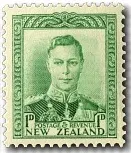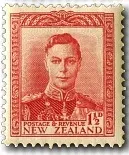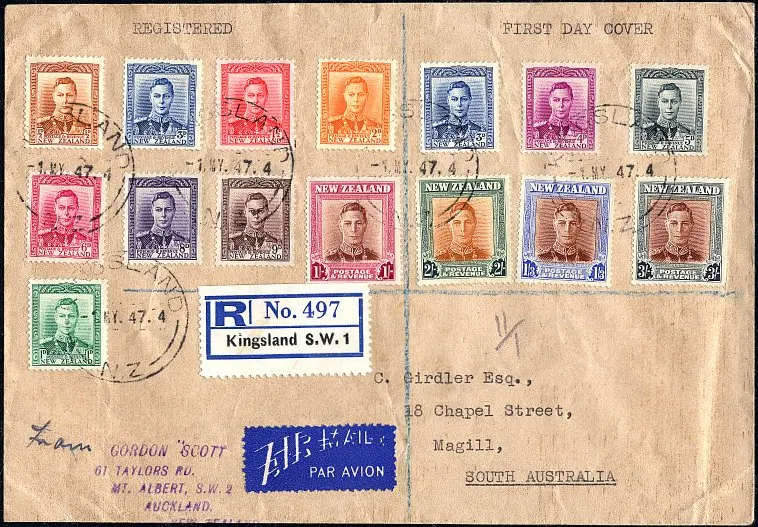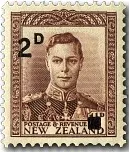Definitive Tour.
Back to 1935 Pictorials. Forward to Elizabeth II Definitives.
King George VI Coronation.
King George VI was the second son of King George V and his wife, Queen Elizabeth, was the youngest daughter of Scottish aristocrat Claude Bowes-Lyon, 14th Earl of Strathmore and Kinghorne.Back to 1935 Pictorials. Forward to Elizabeth II Definitives.
King George VI Coronation.
In 1936 following the abdication from the throne of his elder brother (King Edward VIII), the Duke of York became King George VI. The coronation of King George VI and Queen Elizabeth took place at Westminster Abbey the following year. To mark this event New Zealand issued this set of three values.
They had two children, Princess Elizabeth (now Queen Elizabeth II), born in 1926
and Princess Margaret, born in 1930.
1940 Centennials.
This stamp showing King George VI first appeared in the 1940 Centennials as the 1 1/2d then it was overprinted and re-issued in 1944 with a 10d value.
The design is very interesting in that it also shows four other royal heads of state. In the top left corner is Queen Victoria. In the top right side is her son King Edward VII. In the lower left is Edward's son King George V. George V had two sons, King Edward VIII in the bottom right corner and of course King George VI in the centre. On the left is the flag of Britain and on the right the flag of New Zealand.
1946 Peace Issue.
1946 Peace - 1d 1946 Peace - 2d
The 1946 Peace issue featured two values showing King George IV. In the first 1d stamp he is shown in an insert with the New Zealand Parliament Buildings. On the 2d he is shown with his family, his wife Queen Elizabeth and daughters Elizabeth and Margaret.
1938 - 1947 Definitives.
The 1938 King George VI Definitive Issue is divided into two groups. The thirteen lower values were single colour designs showing the king in a full-face portrait. The four higher values show the same portrait but in a two colour design.



1938 - 1/2d Green. 1941 - 1/2d Chestnut. 1838 - 1d Scarlet.


1941 - 1d Green. 1938 - 1 1/2d Chocolate.
1947 - 2d Yellow/Orange. 1944 - 1 1/2d Rose/Red. 1941 - 3d Blue.
1947 - 1s Brown & Claret. 1947 - 1s 3d Brown & Light-Blue
1947 - 2s Brown & Deep-Green 1947 - 3s Brown & Grey.
Brown colour shift up. You can see that the
King's head is touching the top frame.
1947 First Day Cover.
This is an FDC from Gordon Scott of Mt Albert, Auckland which was sent to C Girdler in South Australia. Notice that it was postmarked in Kingsland on the 1st May 1947. It has a registered letter, (white sticker) and sent via airmail, (blue sticker).
Another interesting cover which flew on the Inaugural Flight of a Tasman Empire Airways Ltd (TEAL) sea-plane between Auckland and Papeete and returned on 26 Dec 1951. TEAL at that time flew sea-planes but they would later become the national airline, Air New Zealand.
Also look closely at the stamp on this cover. The brown has actually shifted to the right, note the strip of white between the brown and the border on the left-hand side.
Also look closely at the stamp on this cover. The brown has actually shifted to the right, note the strip of white between the brown and the border on the left-hand side.
1941 King George VI Provisionals.
During the Second World War, postal rates increased by ½d while stamp colours still had to meet the Universal Postal Union's requirements. To fill this role, the ½d stamp from the 1938 King George VI issue was surcharged 1d and the 1½d stamp surcharged 2d. This was a temporary measure to use up stocks and the stamps were printed in the correct colours without the surcharge later in 1941.
1d Overprint On ½d Green. 2d Overprint On 1½d Chocolate Brown.
1952/53 King George VI Provisionals.
King George VI died on the 6th of February 1952 and it became obvious that stocks of the George VI stamps should be used up. In December of that year, an increase in postal charges was met by surcharging the George VI 1d green stamp 3d.
In September 1953, an over-supply of ½d brown George VI stamps were surcharged 1d to use them up.
In September 1953, an over-supply of ½d brown George VI stamps were surcharged 1d to use them up.
1d On ½d Brown (1953). 3d On 1d Green (1952).
From 1891 stamps affixed to official government mail were overprinted by rubber stamps at the time of posting with the letters 'O.P.S.O' - 'On Public Service Only'. In August 1906 Government decided that the existing system of franking letters, packets and telegrams sent on public service, was to be abolished and that in lieu thereof such correspondence "is to be paid for by means of official stamps". Fourteen of the King George VI series were overprinted with the word "Official".
Following this tradition, New Zealand released a second set of King George VI definitive overprints with the word "Official." These were for use by government departments for official use. Again the same format was used with twelve lower values and two higher values. You will find some examples of their use on the covers at the bottom.
To view all the 'Official stamps produced by New Zealand visit An Official Post.
1938 - 1/2d Green. 1946 - 1/2d Chestnut.
1947 - 6d Carmine. 1947 - 8d Violet. 1947 - 9d Brown/Sepia.
1947 - 1s Brown & Claret. 1947 - 2s Brown & Green.
Official Covers.
A cover from the State Insurance Office.
A cover from the National Film Unit.
Now to finish this post here is something a bit different. An interesting window cover which shows an official stamp from the 1940 Centennials (see above) and one of the King George VI Definitives. Of course, both carry clear portraits of the King.
Technical Information.
Date of issue: 1 March 1938.
Designers: Bradbury Wilkinson, England; Thomas De La Rue, England and W.J. Cooch, Wellington.
Printers: Bradbury Wilkinson, England and Thomas De La Rue, England.
Stamp size: 1/2d - 9d: 20mm x 22mm; 1s, 1s 3d, 2s and 3s : 24mm x 27mm.
Sheet size: Pence Values: Sheets of 240 stamps; Shilling Values: Sheets of 160; Booklets of 1/2d, 1d and 11/2d stamps.
Process: Recess printed - Intaglio.
Perforation gauge: 1/2d - 9d: 14 x 13.5; 1s - 3s : 14.
Paper type: Wiggins Teape 'Esparto' and 'Royal Cypher', multiple NZ and star watermark; St Cuthbert's 'Esparto' and 'Royal Cypher', multiple NZ and star watermark/
Some of the images in this post were used with permission from the illustrated catalogue of StampsNZ
You can visit their website and Online Catalogue at, http://stampsnz.com/
Information & images for this post came from.













































Now this was an interesting story. They were a bit before my time but I remember seeing many of the minor values when I tired collection stamps as a kid.
ReplyDeleteAgain I like the way you have laid out and explained the whole story of this King and his definitive issue.
Deanna.
We appreciate your engagement with our content. To ensure a respectful and constructive community, please take note of the following:
- No Spam, Please: We do not tolerate spammy or promotional comments. Any such comments will be promptly removed.
- Moderation in Place: All comments are moderated to maintain a positive and inclusive environment. Please be patient, as it may take a little time for your comment to appear.
- Sign In with Google: To comment, please sign in using your Google account. This helps us maintain the integrity of our community and allows for better interaction.